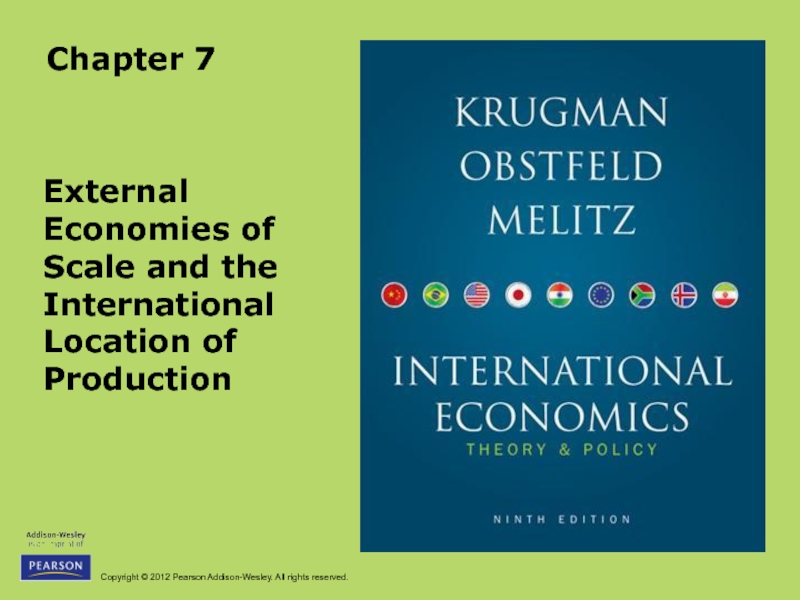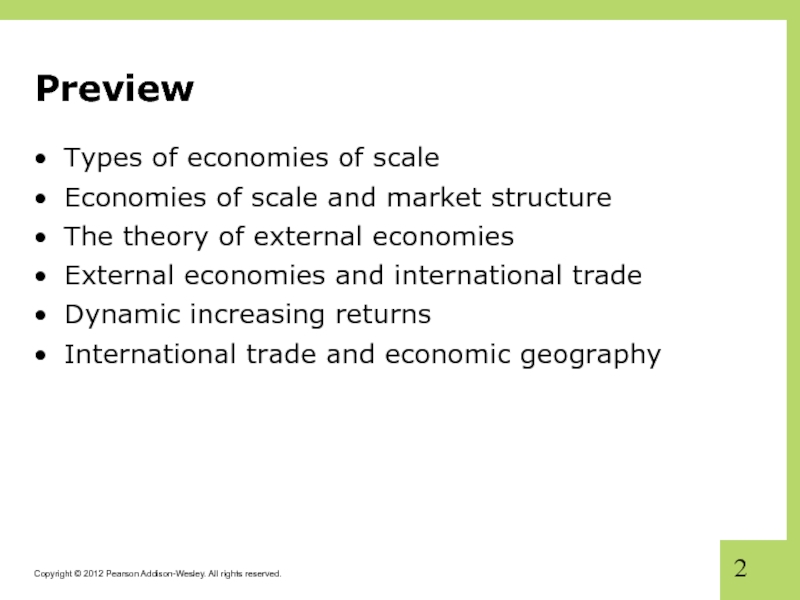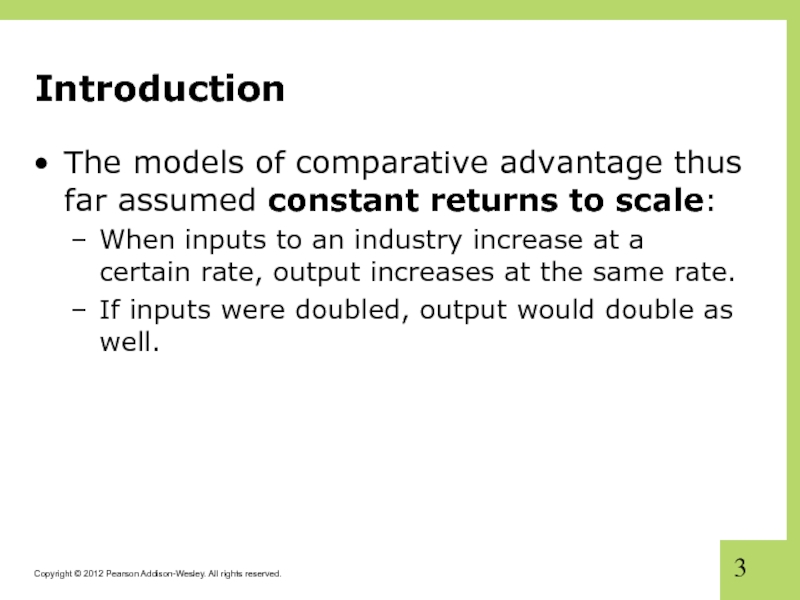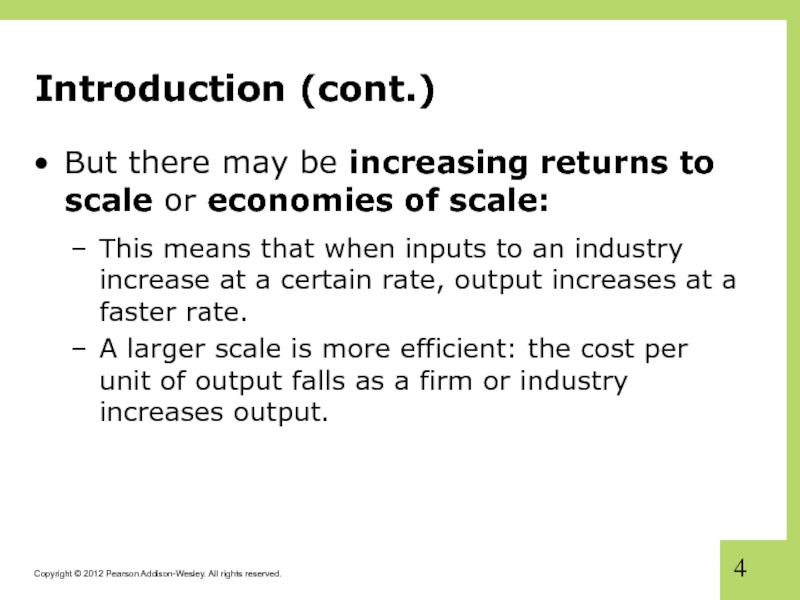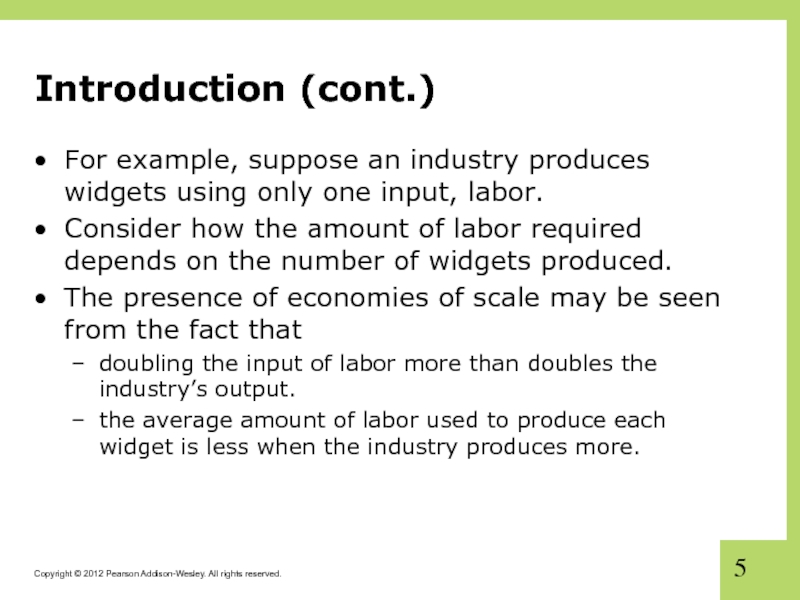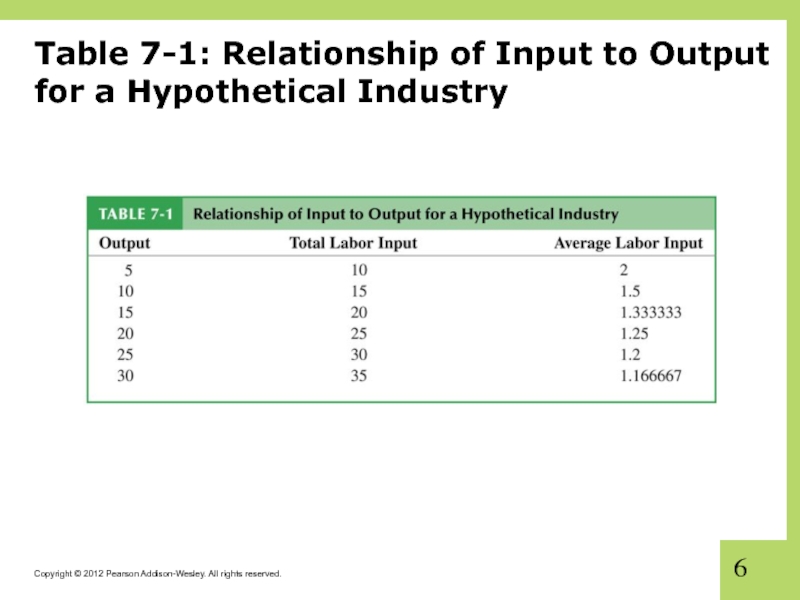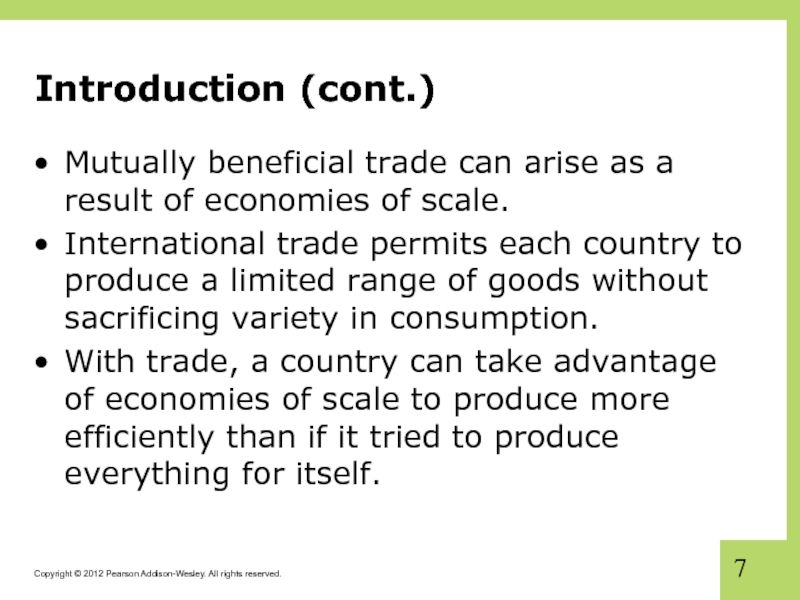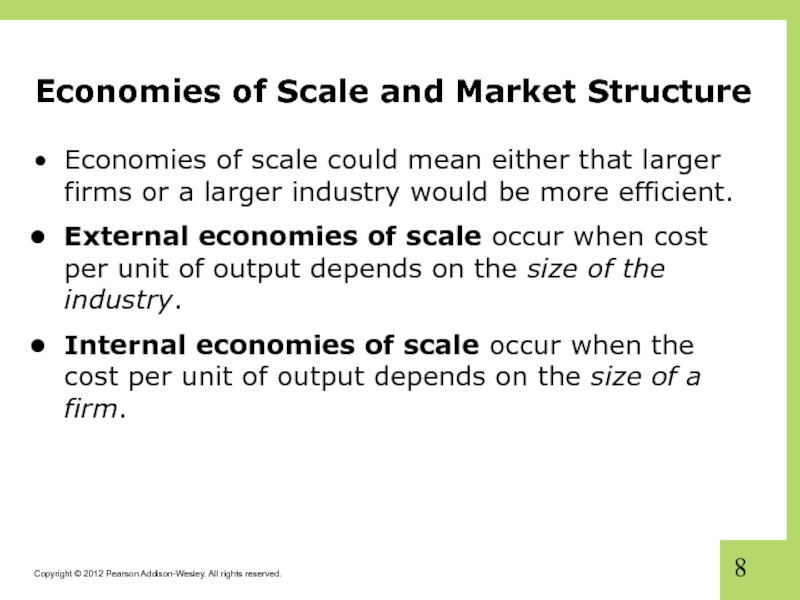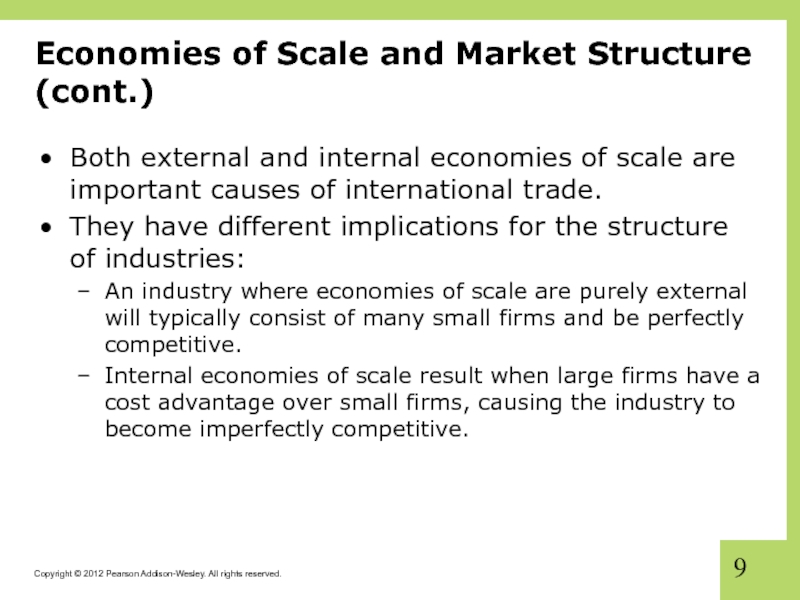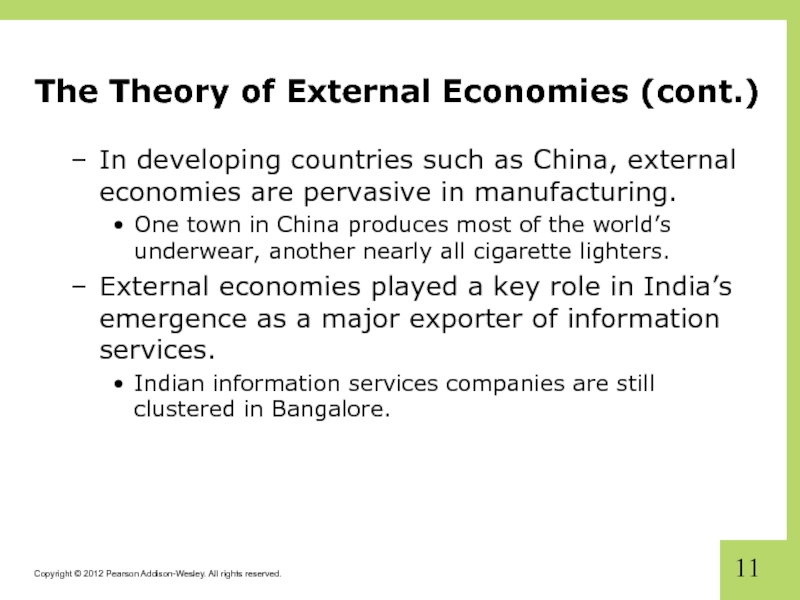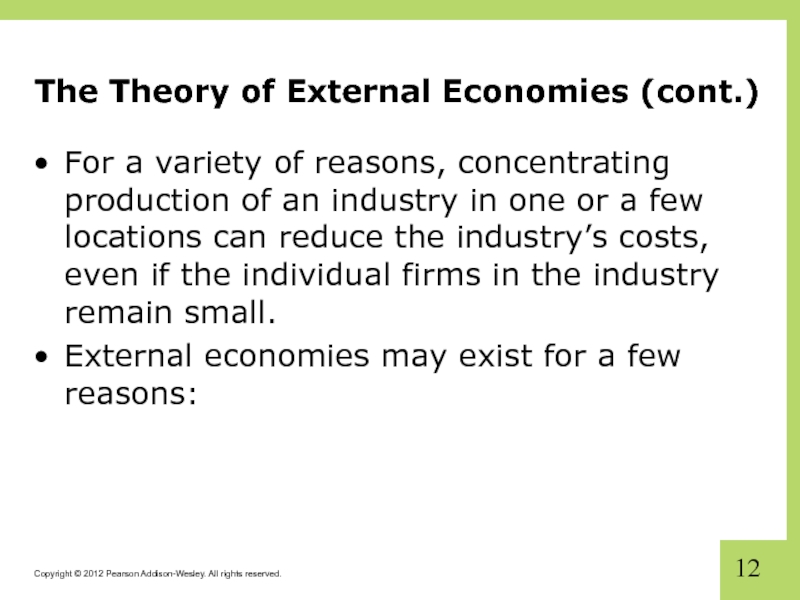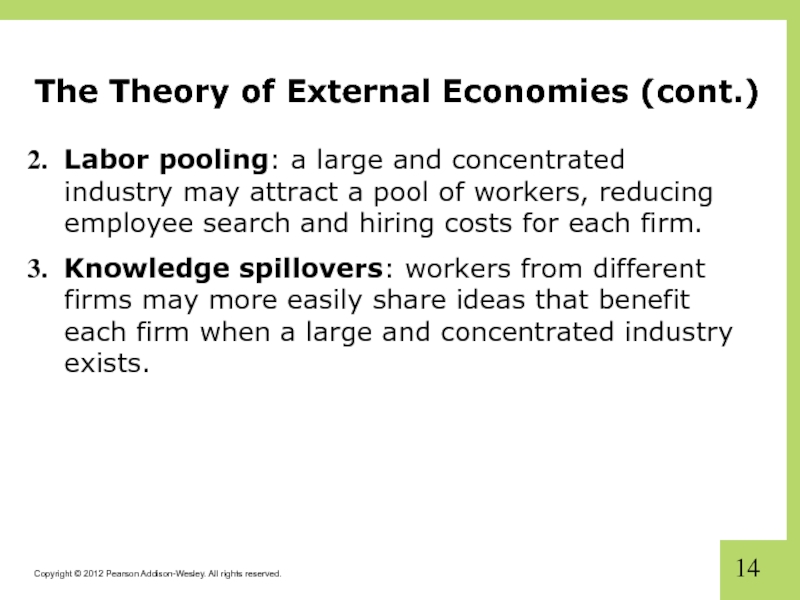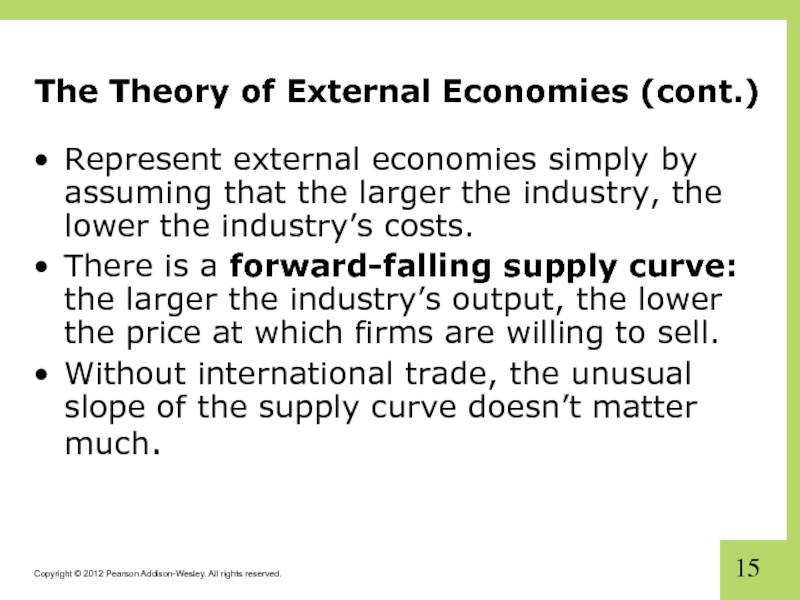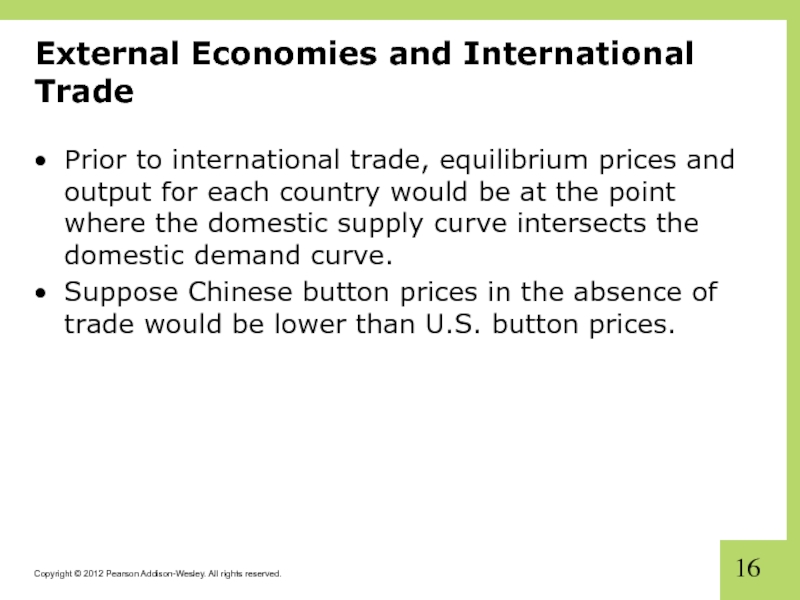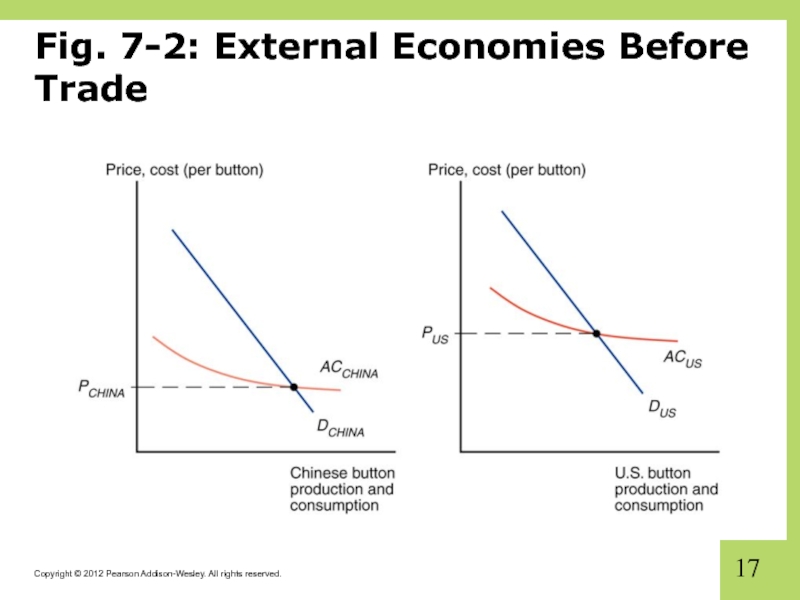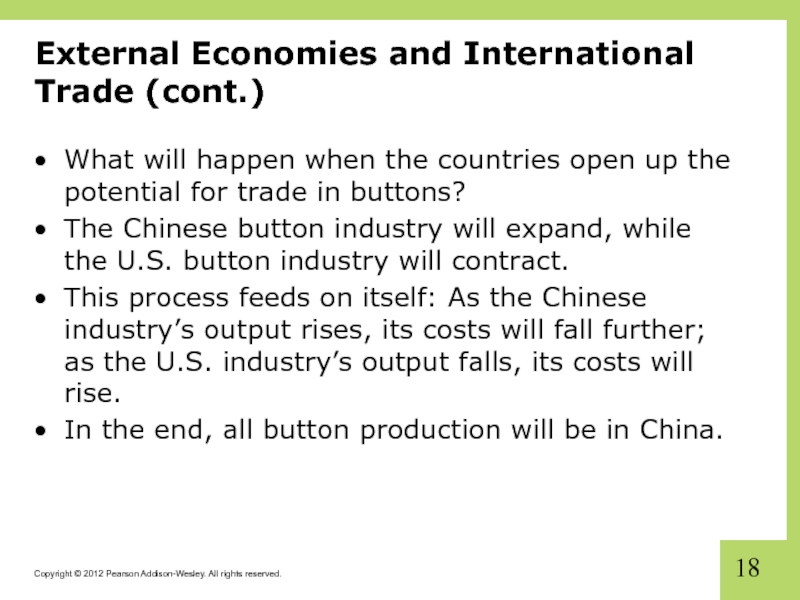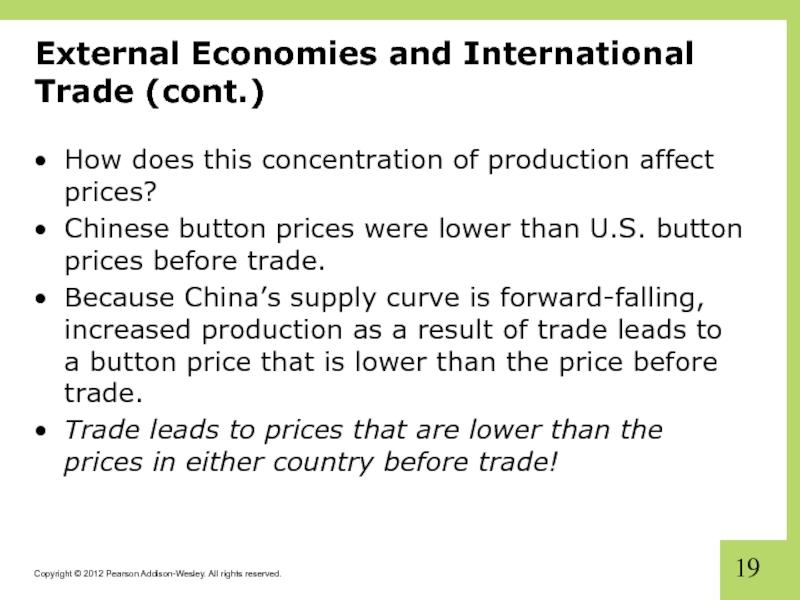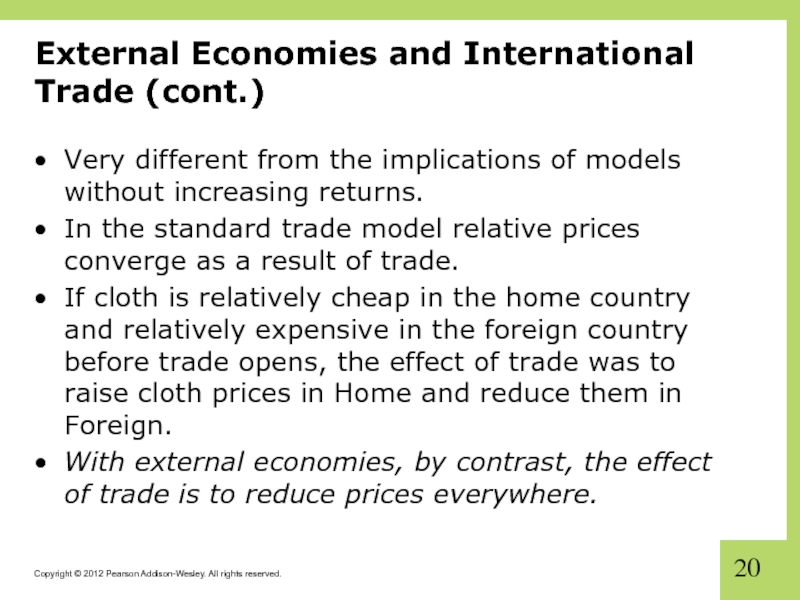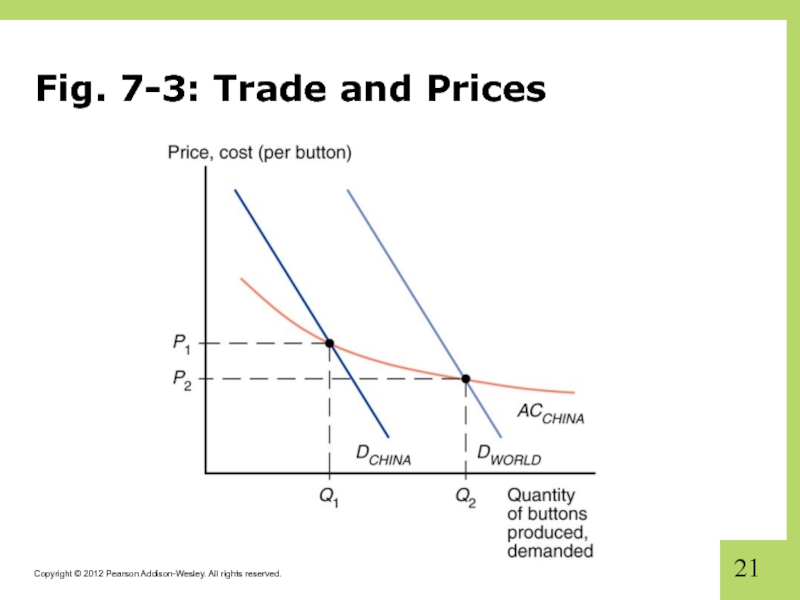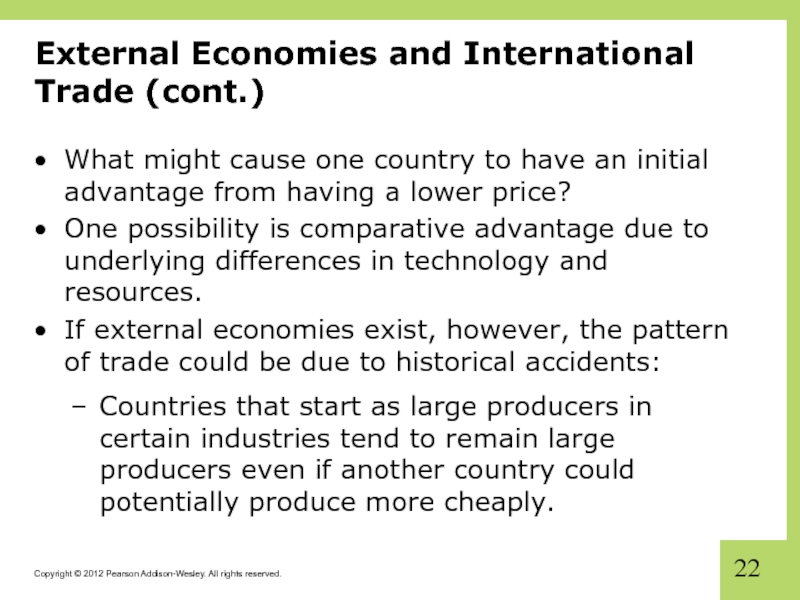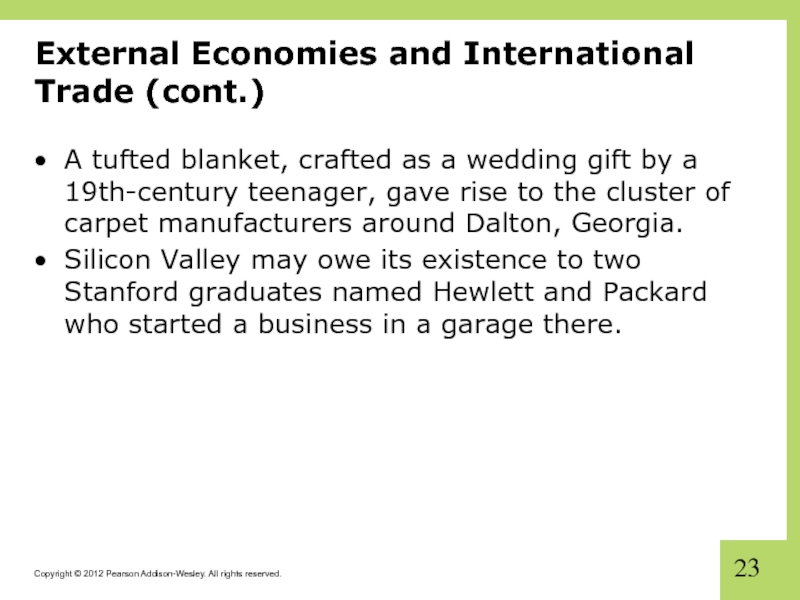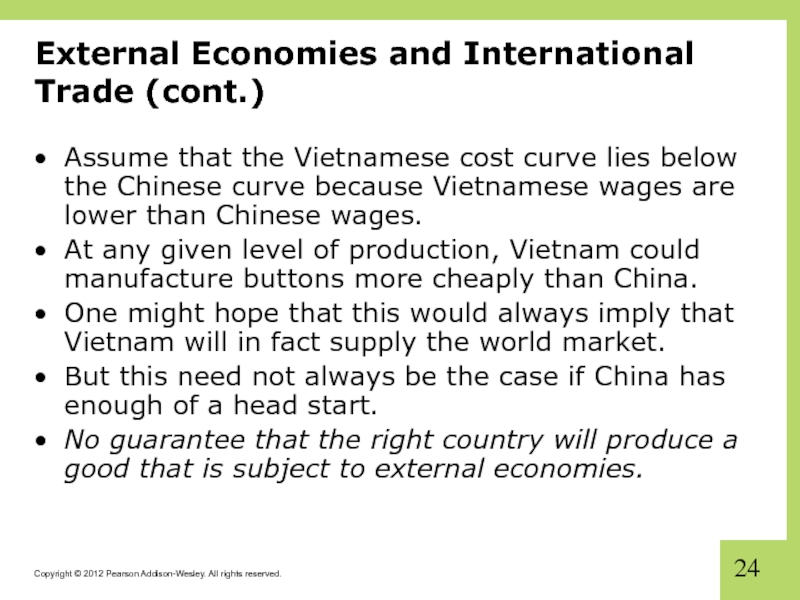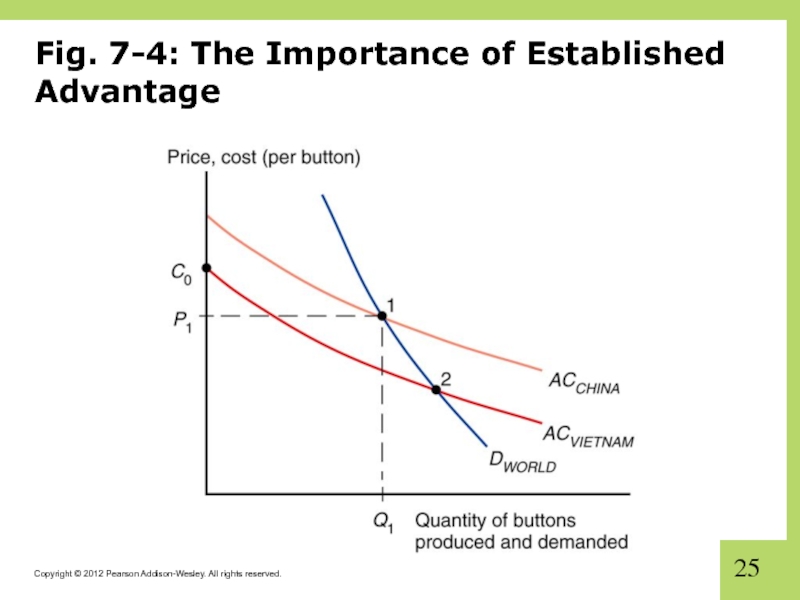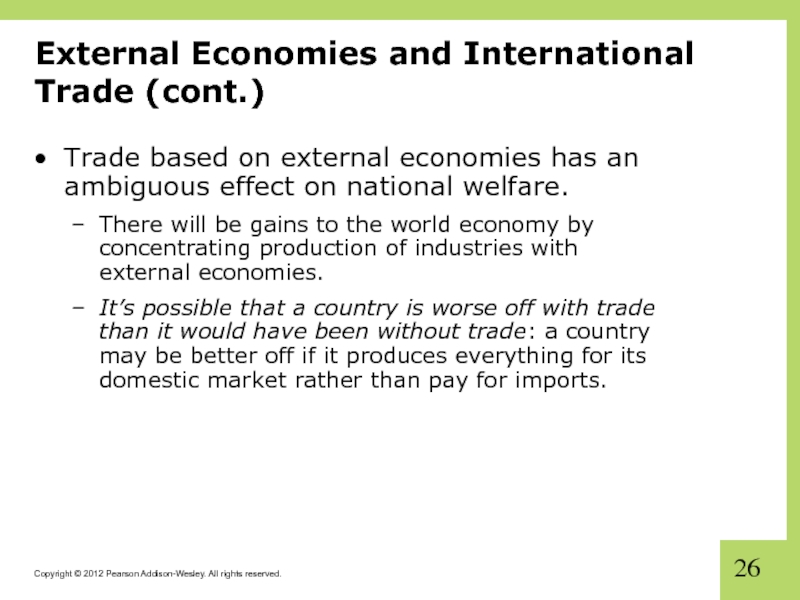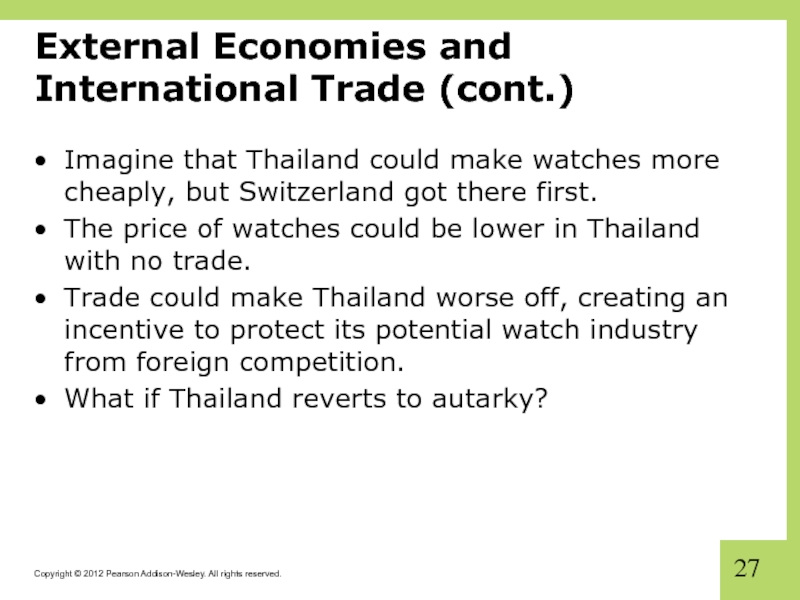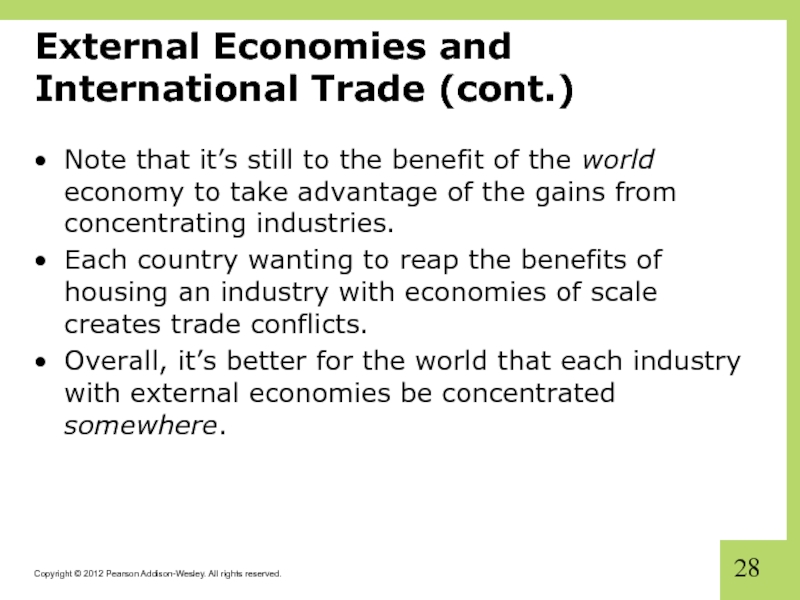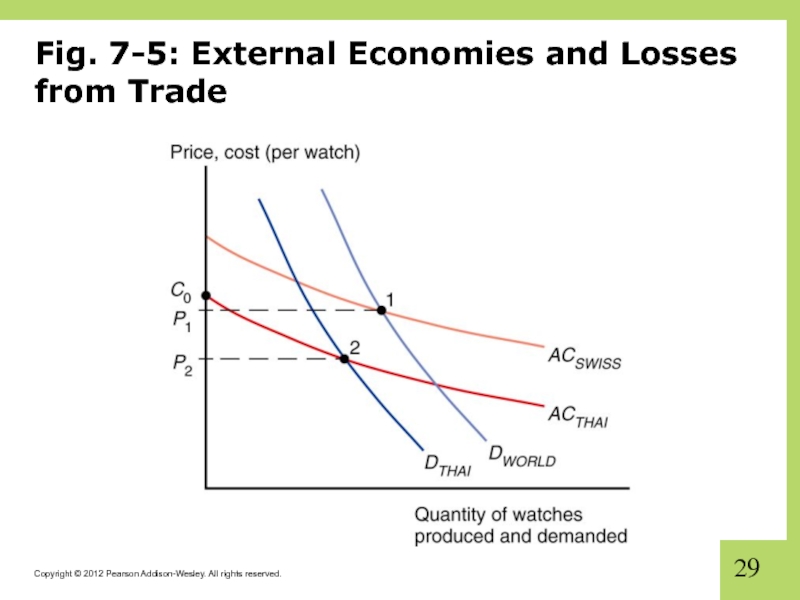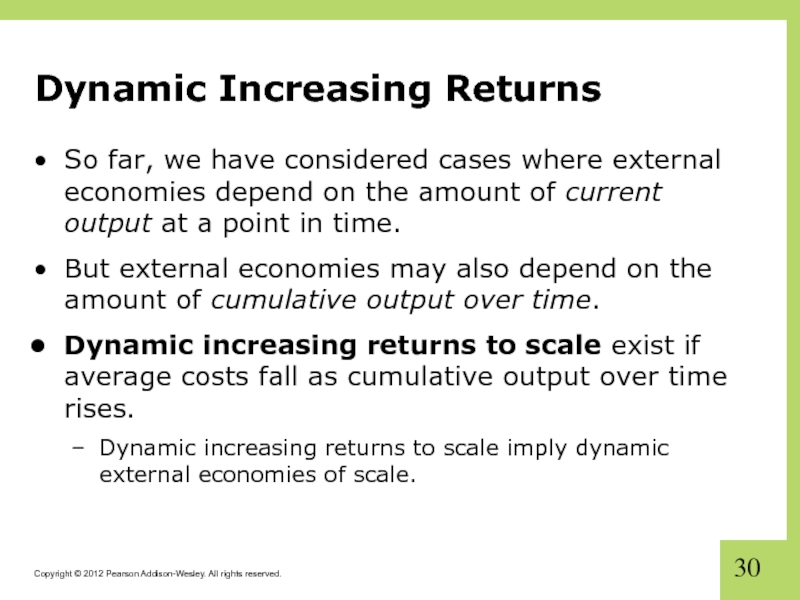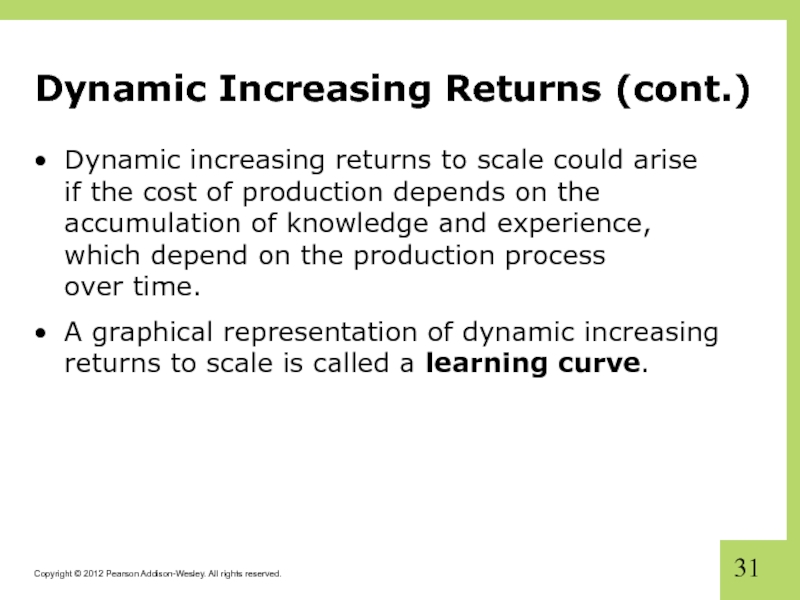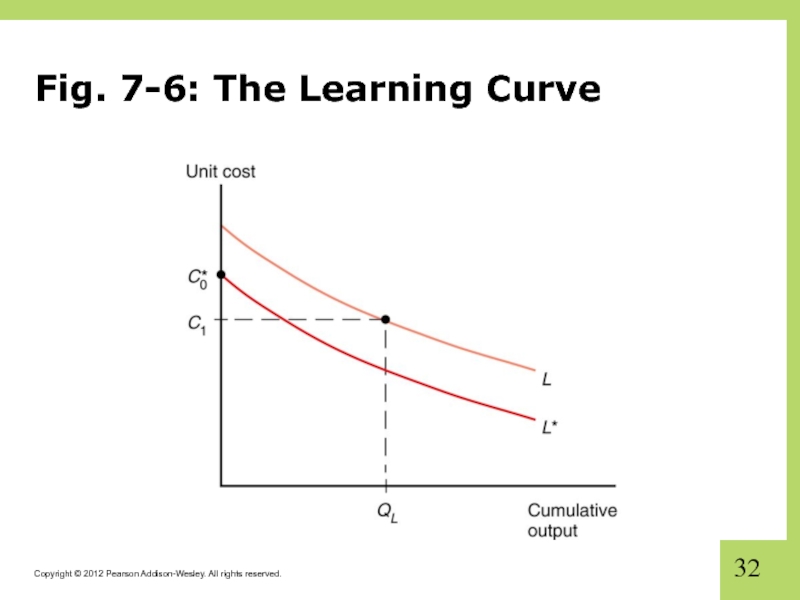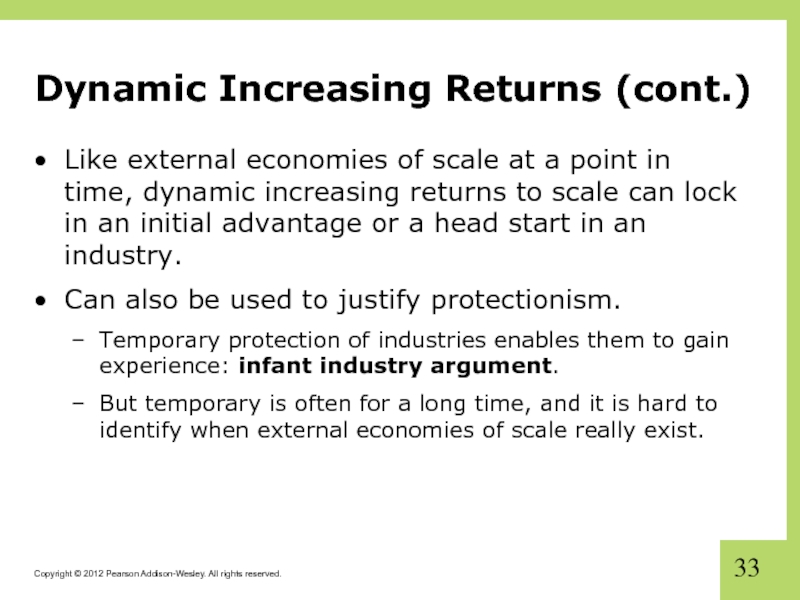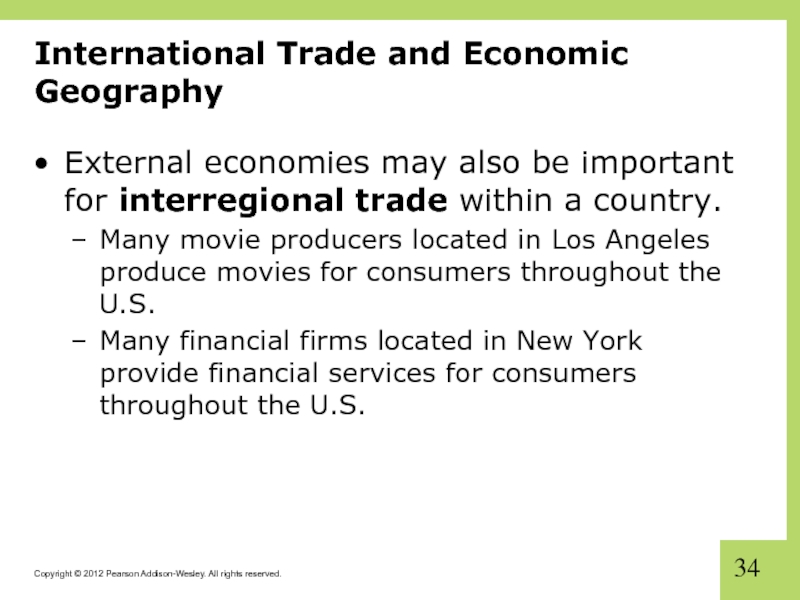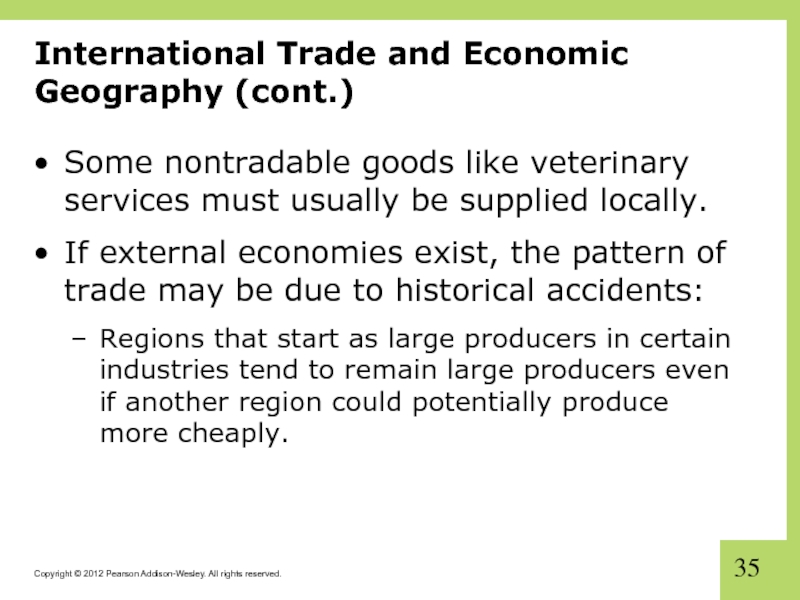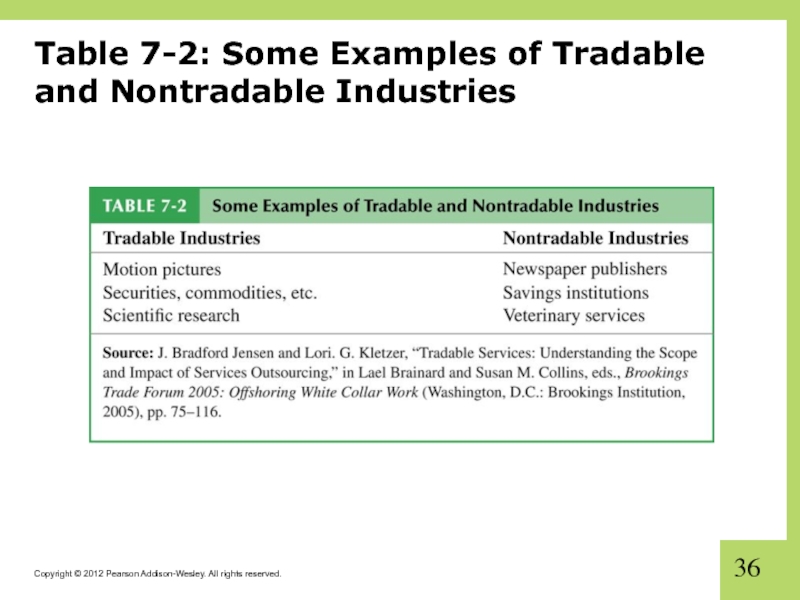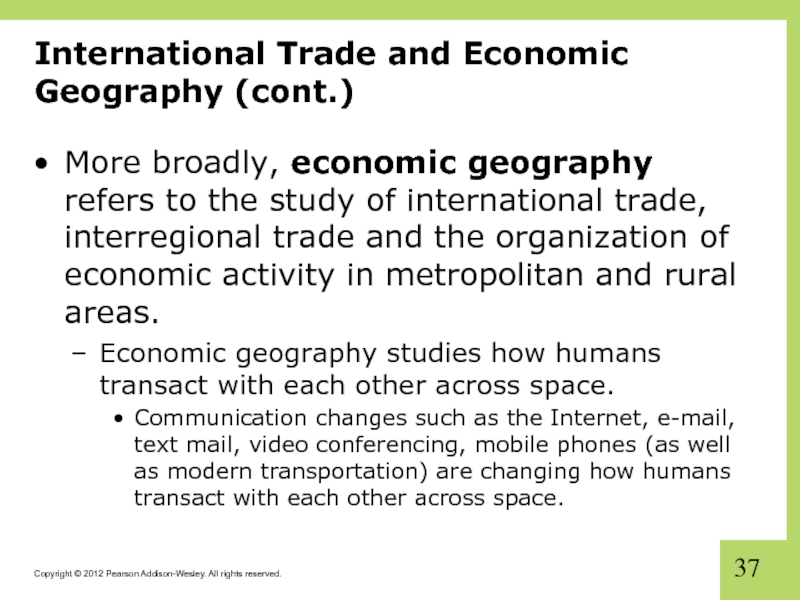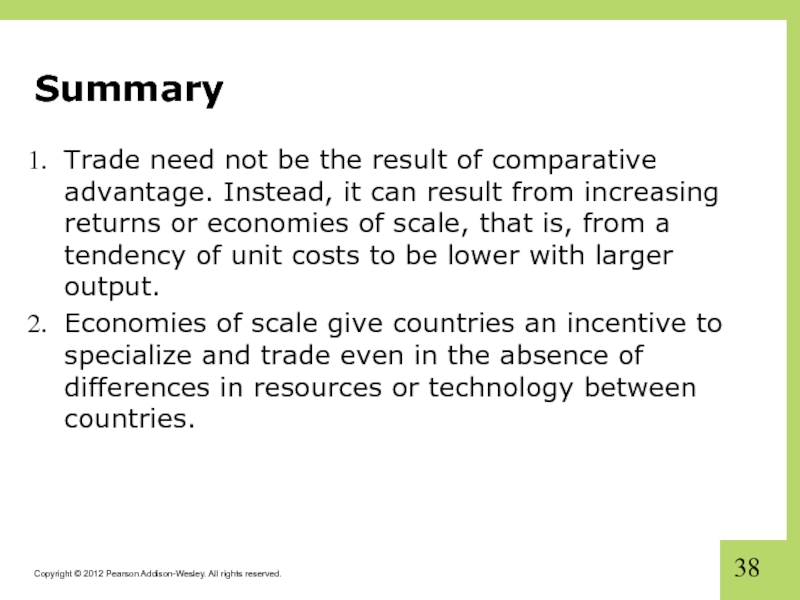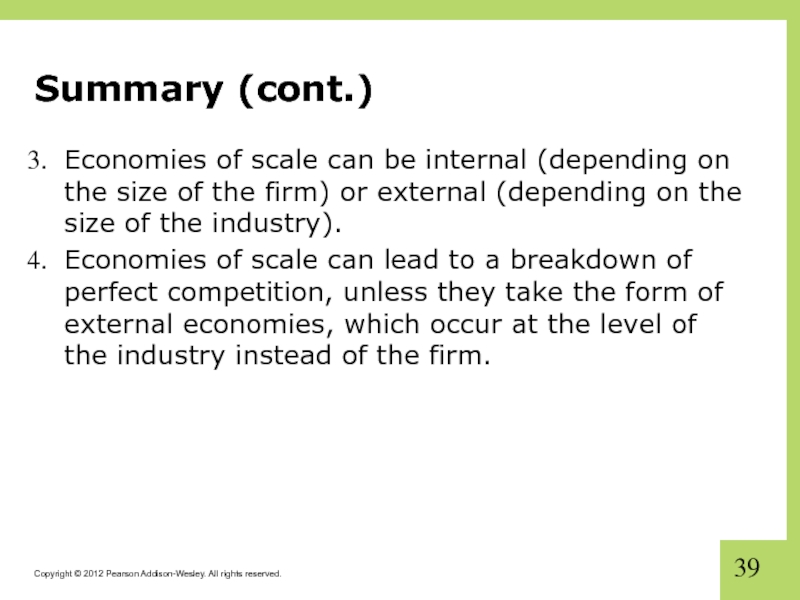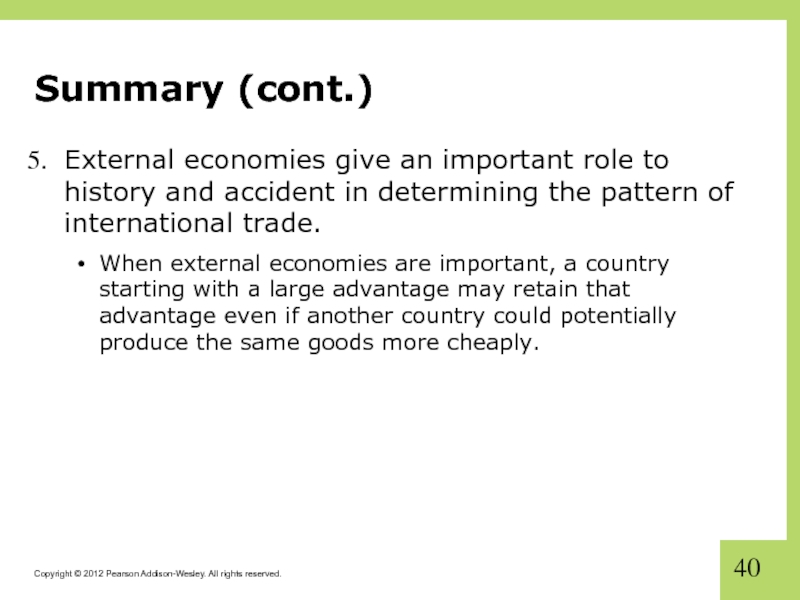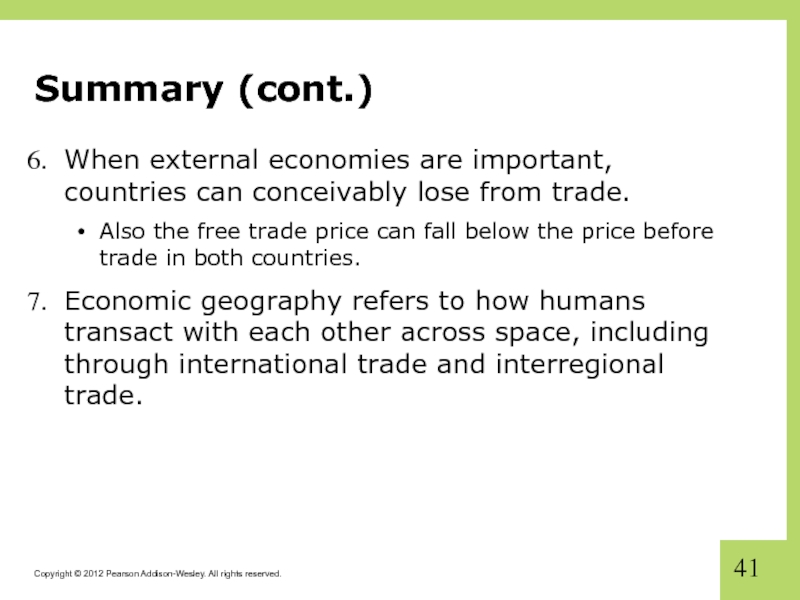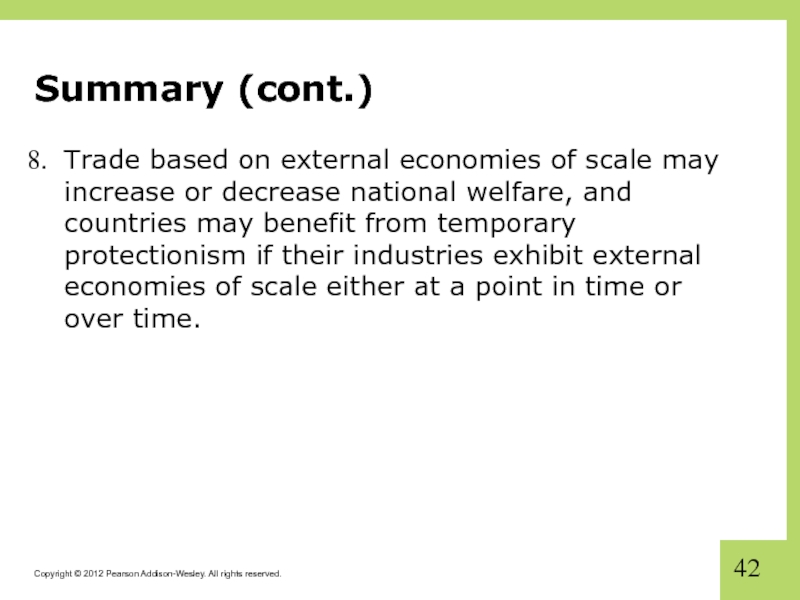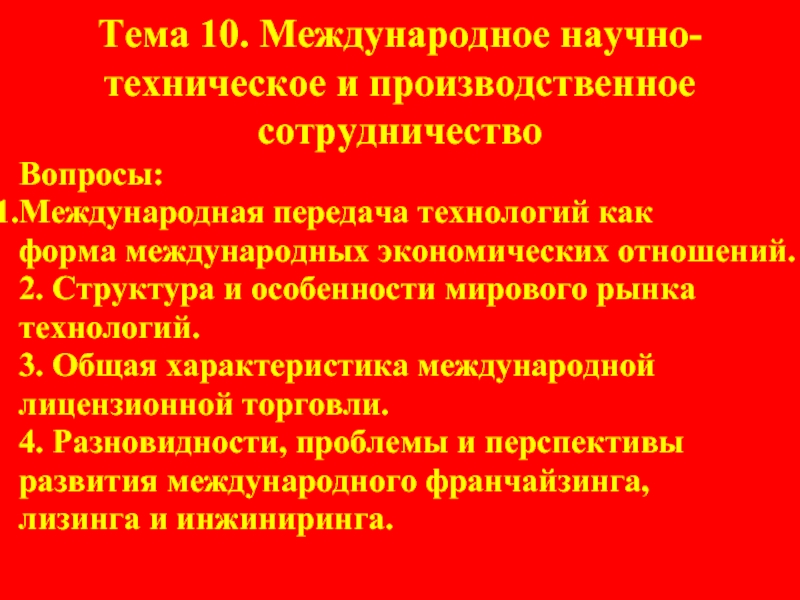- Главная
- Разное
- Дизайн
- Бизнес и предпринимательство
- Аналитика
- Образование
- Развлечения
- Красота и здоровье
- Финансы
- Государство
- Путешествия
- Спорт
- Недвижимость
- Армия
- Графика
- Культурология
- Еда и кулинария
- Лингвистика
- Английский язык
- Астрономия
- Алгебра
- Биология
- География
- Детские презентации
- Информатика
- История
- Литература
- Маркетинг
- Математика
- Медицина
- Менеджмент
- Музыка
- МХК
- Немецкий язык
- ОБЖ
- Обществознание
- Окружающий мир
- Педагогика
- Русский язык
- Технология
- Физика
- Философия
- Химия
- Шаблоны, картинки для презентаций
- Экология
- Экономика
- Юриспруденция
External Economies of Scale and the International Location of Production презентация
Содержание
- 1. External Economies of Scale and the International Location of Production
- 2. Preview Types of economies of scale Economies
- 3. Introduction The models of comparative advantage thus
- 4. Introduction (cont.) But there may be increasing
- 5. Introduction (cont.) For example, suppose an industry
- 6. Table 7-1: Relationship of Input to Output for a Hypothetical Industry
- 7. Introduction (cont.) Mutually beneficial trade can arise
- 8. Economies of Scale and Market Structure Economies
- 9. Economies of Scale and Market Structure (cont.)
- 10. The Theory of External Economies This chapter
- 11. The Theory of External Economies (cont.) In
- 12. The Theory of External Economies (cont.) For
- 13. The Theory of External Economies (cont.) Specialized
- 14. The Theory of External Economies (cont.) Labor
- 15. The Theory of External Economies (cont.) Represent
- 16. External Economies and International Trade Prior to
- 17. Fig. 7-2: External Economies Before Trade
- 18. External Economies and International Trade (cont.) What
- 19. External Economies and International Trade (cont.) How
- 20. External Economies and International Trade (cont.) Very
- 21. Fig. 7-3: Trade and Prices
- 22. External Economies and International Trade (cont.) What
- 23. External Economies and International Trade (cont.) A
- 24. External Economies and International Trade (cont.) Assume
- 25. Fig. 7-4: The Importance of Established Advantage
- 26. External Economies and International Trade (cont.) Trade
- 27. External Economies and International Trade (cont.) Imagine
- 28. External Economies and International Trade (cont.) Note
- 29. Fig. 7-5: External Economies and Losses from Trade
- 30. Dynamic Increasing Returns So far, we have
- 31. Dynamic Increasing Returns (cont.) Dynamic increasing returns
- 32. Fig. 7-6: The Learning Curve
- 33. Dynamic Increasing Returns (cont.) Like external economies
- 34. International Trade and Economic Geography External economies
- 35. International Trade and Economic Geography (cont.) Some
- 36. Table 7-2: Some Examples of Tradable and Nontradable Industries
- 37. International Trade and Economic Geography (cont.) More
- 38. Summary Trade need not be the result
- 39. Summary (cont.) Economies of scale can be
- 40. Summary (cont.) External economies give an important
- 41. Summary (cont.) When external economies are important,
- 42. Summary (cont.) Trade based on external economies
Слайд 2Preview
Types of economies of scale
Economies of scale and market structure
The theory
of external economies
External economies and international trade
Dynamic increasing returns
International trade and economic geography
External economies and international trade
Dynamic increasing returns
International trade and economic geography
Слайд 3Introduction
The models of comparative advantage thus far assumed constant returns to
scale:
When inputs to an industry increase at a certain rate, output increases at the same rate.
If inputs were doubled, output would double as well.
When inputs to an industry increase at a certain rate, output increases at the same rate.
If inputs were doubled, output would double as well.
Слайд 4Introduction (cont.)
But there may be increasing returns to scale or economies
of scale:
This means that when inputs to an industry increase at a certain rate, output increases at a faster rate.
A larger scale is more efficient: the cost per unit of output falls as a firm or industry increases output.
This means that when inputs to an industry increase at a certain rate, output increases at a faster rate.
A larger scale is more efficient: the cost per unit of output falls as a firm or industry increases output.
Слайд 5Introduction (cont.)
For example, suppose an industry produces widgets using only one
input, labor.
Consider how the amount of labor required depends on the number of widgets produced.
The presence of economies of scale may be seen from the fact that
doubling the input of labor more than doubles the industry’s output.
the average amount of labor used to produce each widget is less when the industry produces more.
Consider how the amount of labor required depends on the number of widgets produced.
The presence of economies of scale may be seen from the fact that
doubling the input of labor more than doubles the industry’s output.
the average amount of labor used to produce each widget is less when the industry produces more.
Слайд 7Introduction (cont.)
Mutually beneficial trade can arise as a result of economies
of scale.
International trade permits each country to produce a limited range of goods without sacrificing variety in consumption.
With trade, a country can take advantage of economies of scale to produce more efficiently than if it tried to produce everything for itself.
International trade permits each country to produce a limited range of goods without sacrificing variety in consumption.
With trade, a country can take advantage of economies of scale to produce more efficiently than if it tried to produce everything for itself.
Слайд 8Economies of Scale and Market Structure
Economies of scale could mean either
that larger firms or a larger industry would be more efficient.
External economies of scale occur when cost per unit of output depends on the size of the industry.
Internal economies of scale occur when the cost per unit of output depends on the size of a firm.
External economies of scale occur when cost per unit of output depends on the size of the industry.
Internal economies of scale occur when the cost per unit of output depends on the size of a firm.
Слайд 9Economies of Scale and Market Structure (cont.)
Both external and internal economies
of scale are important causes of international trade.
They have different implications for the structure of industries:
An industry where economies of scale are purely external will typically consist of many small firms and be perfectly competitive.
Internal economies of scale result when large firms have a cost advantage over small firms, causing the industry to become imperfectly competitive.
They have different implications for the structure of industries:
An industry where economies of scale are purely external will typically consist of many small firms and be perfectly competitive.
Internal economies of scale result when large firms have a cost advantage over small firms, causing the industry to become imperfectly competitive.
Слайд 10The Theory of External Economies
This chapter deals with a model of
external economies; the next chapter will cover internal economies.
Many modern examples of industries that seem to be powerful external economies:
In the United States, the semiconductor industry is concentrated in Silicon Valley, investment banking in New York, and the entertainment industry in Hollywood.
Many modern examples of industries that seem to be powerful external economies:
In the United States, the semiconductor industry is concentrated in Silicon Valley, investment banking in New York, and the entertainment industry in Hollywood.
Слайд 11The Theory of External Economies (cont.)
In developing countries such as China,
external economies are pervasive in manufacturing.
One town in China produces most of the world’s underwear, another nearly all cigarette lighters.
External economies played a key role in India’s emergence as a major exporter of information services.
Indian information services companies are still clustered in Bangalore.
One town in China produces most of the world’s underwear, another nearly all cigarette lighters.
External economies played a key role in India’s emergence as a major exporter of information services.
Indian information services companies are still clustered in Bangalore.
Слайд 12The Theory of External Economies (cont.)
For a variety of reasons, concentrating
production of an industry in one or a few locations can reduce the industry’s costs, even if the individual firms in the industry remain small.
External economies may exist for a few reasons:
External economies may exist for a few reasons:
Слайд 13The Theory of External Economies (cont.)
Specialized equipment or services may
be
needed for the industry, but are only supplied by other firms if the industry is large and concentrated.
For example, Silicon Valley in California has a large concentration of silicon chip companies, which are serviced by companies that make special machines for manufacturing silicon chips.
These machines are cheaper and more easily available there than elsewhere.
For example, Silicon Valley in California has a large concentration of silicon chip companies, which are serviced by companies that make special machines for manufacturing silicon chips.
These machines are cheaper and more easily available there than elsewhere.
Слайд 14The Theory of External Economies (cont.)
Labor pooling: a large and concentrated
industry may attract a pool of workers, reducing employee search and hiring costs for each firm.
Knowledge spillovers: workers from different firms may more easily share ideas that benefit each firm when a large and concentrated industry exists.
Knowledge spillovers: workers from different firms may more easily share ideas that benefit each firm when a large and concentrated industry exists.
Слайд 15The Theory of External Economies (cont.)
Represent external economies simply by assuming
that the larger the industry, the lower the industry’s costs.
There is a forward-falling supply curve: the larger the industry’s output, the lower the price at which firms are willing to sell.
Without international trade, the unusual slope of the supply curve doesn’t matter much.
There is a forward-falling supply curve: the larger the industry’s output, the lower the price at which firms are willing to sell.
Without international trade, the unusual slope of the supply curve doesn’t matter much.
Слайд 16External Economies and International Trade
Prior to international trade, equilibrium prices and
output for each country would be at the point where the domestic supply curve intersects the domestic demand curve.
Suppose Chinese button prices in the absence of trade would be lower than U.S. button prices.
Suppose Chinese button prices in the absence of trade would be lower than U.S. button prices.
Слайд 18External Economies and International Trade (cont.)
What will happen when the countries
open up the potential for trade in buttons?
The Chinese button industry will expand, while the U.S. button industry will contract.
This process feeds on itself: As the Chinese industry’s output rises, its costs will fall further; as the U.S. industry’s output falls, its costs will rise.
In the end, all button production will be in China.
The Chinese button industry will expand, while the U.S. button industry will contract.
This process feeds on itself: As the Chinese industry’s output rises, its costs will fall further; as the U.S. industry’s output falls, its costs will rise.
In the end, all button production will be in China.
Слайд 19External Economies and International Trade (cont.)
How does this concentration of production
affect prices?
Chinese button prices were lower than U.S. button prices before trade.
Because China’s supply curve is forward-falling, increased production as a result of trade leads to a button price that is lower than the price before trade.
Trade leads to prices that are lower than the prices in either country before trade!
Chinese button prices were lower than U.S. button prices before trade.
Because China’s supply curve is forward-falling, increased production as a result of trade leads to a button price that is lower than the price before trade.
Trade leads to prices that are lower than the prices in either country before trade!
Слайд 20External Economies and International Trade (cont.)
Very different from the implications of
models without increasing returns.
In the standard trade model relative prices converge as a result of trade.
If cloth is relatively cheap in the home country and relatively expensive in the foreign country before trade opens, the effect of trade was to raise cloth prices in Home and reduce them in Foreign.
With external economies, by contrast, the effect of trade is to reduce prices everywhere.
In the standard trade model relative prices converge as a result of trade.
If cloth is relatively cheap in the home country and relatively expensive in the foreign country before trade opens, the effect of trade was to raise cloth prices in Home and reduce them in Foreign.
With external economies, by contrast, the effect of trade is to reduce prices everywhere.
Слайд 22External Economies and International Trade (cont.)
What might cause one country to
have an initial advantage from having a lower price?
One possibility is comparative advantage due to underlying differences in technology and resources.
If external economies exist, however, the pattern of trade could be due to historical accidents:
Countries that start as large producers in certain industries tend to remain large producers even if another country could potentially produce more cheaply.
One possibility is comparative advantage due to underlying differences in technology and resources.
If external economies exist, however, the pattern of trade could be due to historical accidents:
Countries that start as large producers in certain industries tend to remain large producers even if another country could potentially produce more cheaply.
Слайд 23External Economies and International Trade (cont.)
A tufted blanket, crafted as a
wedding gift by a 19th-century teenager, gave rise to the cluster of carpet manufacturers around Dalton, Georgia.
Silicon Valley may owe its existence to two Stanford graduates named Hewlett and Packard who started a business in a garage there.
Silicon Valley may owe its existence to two Stanford graduates named Hewlett and Packard who started a business in a garage there.
Слайд 24External Economies and International Trade (cont.)
Assume that the Vietnamese cost curve
lies below the Chinese curve because Vietnamese wages are lower than Chinese wages.
At any given level of production, Vietnam could manufacture buttons more cheaply than China.
One might hope that this would always imply that Vietnam will in fact supply the world market.
But this need not always be the case if China has enough of a head start.
No guarantee that the right country will produce a good that is subject to external economies.
At any given level of production, Vietnam could manufacture buttons more cheaply than China.
One might hope that this would always imply that Vietnam will in fact supply the world market.
But this need not always be the case if China has enough of a head start.
No guarantee that the right country will produce a good that is subject to external economies.
Слайд 26External Economies and International Trade (cont.)
Trade based on external economies has
an ambiguous effect on national welfare.
There will be gains to the world economy by concentrating production of industries with external economies.
It’s possible that a country is worse off with trade than it would have been without trade: a country may be better off if it produces everything for its domestic market rather than pay for imports.
There will be gains to the world economy by concentrating production of industries with external economies.
It’s possible that a country is worse off with trade than it would have been without trade: a country may be better off if it produces everything for its domestic market rather than pay for imports.
Слайд 27External Economies and International Trade (cont.)
Imagine that Thailand could make watches
more cheaply, but Switzerland got there first.
The price of watches could be lower in Thailand with no trade.
Trade could make Thailand worse off, creating an incentive to protect its potential watch industry from foreign competition.
What if Thailand reverts to autarky?
The price of watches could be lower in Thailand with no trade.
Trade could make Thailand worse off, creating an incentive to protect its potential watch industry from foreign competition.
What if Thailand reverts to autarky?
Слайд 28External Economies and International Trade (cont.)
Note that it’s still to the
benefit of the world economy to take advantage of the gains from concentrating industries.
Each country wanting to reap the benefits of housing an industry with economies of scale creates trade conflicts.
Overall, it’s better for the world that each industry with external economies be concentrated somewhere.
Each country wanting to reap the benefits of housing an industry with economies of scale creates trade conflicts.
Overall, it’s better for the world that each industry with external economies be concentrated somewhere.
Слайд 30Dynamic Increasing Returns
So far, we have considered cases where external economies
depend on the amount of current output at a point in time.
But external economies may also depend on the amount of cumulative output over time.
Dynamic increasing returns to scale exist if average costs fall as cumulative output over time rises.
Dynamic increasing returns to scale imply dynamic external economies of scale.
But external economies may also depend on the amount of cumulative output over time.
Dynamic increasing returns to scale exist if average costs fall as cumulative output over time rises.
Dynamic increasing returns to scale imply dynamic external economies of scale.
Слайд 31Dynamic Increasing Returns (cont.)
Dynamic increasing returns to scale could arise
if the cost of production depends on the accumulation of knowledge and experience, which depend on the production process
over time.
A graphical representation of dynamic increasing returns to scale is called a learning curve.
A graphical representation of dynamic increasing returns to scale is called a learning curve.
Слайд 33Dynamic Increasing Returns (cont.)
Like external economies of scale at a point
in time, dynamic increasing returns to scale can lock in an initial advantage or a head start in an industry.
Can also be used to justify protectionism.
Temporary protection of industries enables them to gain experience: infant industry argument.
But temporary is often for a long time, and it is hard to identify when external economies of scale really exist.
Can also be used to justify protectionism.
Temporary protection of industries enables them to gain experience: infant industry argument.
But temporary is often for a long time, and it is hard to identify when external economies of scale really exist.
Слайд 34International Trade and Economic Geography
External economies may also be important for
interregional trade within a country.
Many movie producers located in Los Angeles produce movies for consumers throughout the U.S.
Many financial firms located in New York provide financial services for consumers throughout the U.S.
Many movie producers located in Los Angeles produce movies for consumers throughout the U.S.
Many financial firms located in New York provide financial services for consumers throughout the U.S.
Слайд 35International Trade and Economic Geography (cont.)
Some nontradable goods like veterinary services
must usually be supplied locally.
If external economies exist, the pattern of trade may be due to historical accidents:
Regions that start as large producers in certain industries tend to remain large producers even if another region could potentially produce more cheaply.
If external economies exist, the pattern of trade may be due to historical accidents:
Regions that start as large producers in certain industries tend to remain large producers even if another region could potentially produce more cheaply.
Слайд 37International Trade and Economic Geography (cont.)
More broadly, economic geography refers to
the study of international trade, interregional trade and the organization of economic activity in metropolitan and rural areas.
Economic geography studies how humans transact with each other across space.
Communication changes such as the Internet, e-mail, text mail, video conferencing, mobile phones (as well as modern transportation) are changing how humans transact with each other across space.
Economic geography studies how humans transact with each other across space.
Communication changes such as the Internet, e-mail, text mail, video conferencing, mobile phones (as well as modern transportation) are changing how humans transact with each other across space.
Слайд 38Summary
Trade need not be the result of comparative advantage. Instead, it
can result from increasing returns or economies of scale, that is, from a tendency of unit costs to be lower with larger output.
Economies of scale give countries an incentive to specialize and trade even in the absence of differences in resources or technology between countries.
Economies of scale give countries an incentive to specialize and trade even in the absence of differences in resources or technology between countries.
Слайд 39Summary (cont.)
Economies of scale can be internal (depending on the size
of the firm) or external (depending on the size of the industry).
Economies of scale can lead to a breakdown of perfect competition, unless they take the form of external economies, which occur at the level of the industry instead of the firm.
Economies of scale can lead to a breakdown of perfect competition, unless they take the form of external economies, which occur at the level of the industry instead of the firm.
Слайд 40Summary (cont.)
External economies give an important role to history and accident
in determining the pattern of international trade.
When external economies are important, a country starting with a large advantage may retain that advantage even if another country could potentially produce the same goods more cheaply.
When external economies are important, a country starting with a large advantage may retain that advantage even if another country could potentially produce the same goods more cheaply.
Слайд 41Summary (cont.)
When external economies are important, countries can conceivably lose from
trade.
Also the free trade price can fall below the price before trade in both countries.
Economic geography refers to how humans transact with each other across space, including through international trade and interregional trade.
Also the free trade price can fall below the price before trade in both countries.
Economic geography refers to how humans transact with each other across space, including through international trade and interregional trade.
Слайд 42Summary (cont.)
Trade based on external economies of scale may increase or
decrease national welfare, and countries may benefit from temporary protectionism if their industries exhibit external economies of scale either at a point in time or over time.
